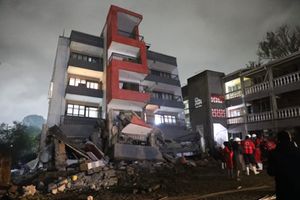How can people who are in informal jobs get mortgages?

Kenya Mortgage Refinance Company Chief Executive Officer Johnstone Oltetia.
The housing loans that KMRC offers are capped at between Sh3 million and Sh4 million for residential units that range between Sh6 million and Sh17 million. This means that eligible borrowers must have other sources of income. Can KMRC increase the loan amounts? Dorcas Mwiti, Ruai
KMRC focuses more on the low-income earners who are most underserved, especially when it comes to access to affordable home financing. Studies show that people who earning less than Sh150,000 per month comprise over 70 per cent of the working population . Therefore, this is the category that deserves to be supported and incentivised to access decent housing. We have been working with the government and other partners to shift financing down to this demographic.
On the supply side, policy interventions have been put in place for purposes of increasing supply of affordable housing units. The recently launched Park Road project in Ngara, Nairobi, with house prices ranging between Sh1 million and Sh4 million is a good example of this. We will soon begin to see greater supply of affordable housing units in Nairobi and the metro area.
KMRC has two lines of credit: one from the World Bank with loans capped at Sh4 million and another line from the African Development Bank with loans capped at Sh8 million. There is, however, a small component, that is, 20 per cent of the World Bank funding that is available to finance residential units above the Sh4 and Sh8 million thresholds.
Can people who are doing informal jobs secure mortgages? Kennedy Mwasio, Murang'a
Yes, they can access KMRC-backed home loans. Anyone who can demonstrate an income sufficient to repay a loan would get financing. KMRC is working with development partners and other key stakeholders to develop risk assessment tools to enable primary lenders to quantify risk in informal incomes to facilitate non-salaried people to access home loans.
Borrowers are supposed to visit any of the participating financial institutions (banks and saccos) to apply for loans. Once their home loans are approved, the institutions will then apply to KMRC to refinance those loans. Interested borrowers may visit the KMRC website www.kmrc.co.ke for more information.
The withdrawal of the compulsory 1.5 per cent housing levy from salaried employees and making the contributions voluntary dealt a big blow to the affordable housing programme under the Big Four Agenda. In the absence of the levy, what strategies are you using to raise funds? Wellington Karani, Gilgil
The 1.5 per cent contribution has no effect on KMRC. Remember this contribution was intended to fund the National Housing Development Fund (NHDF) which is an institution under the Ministry of Transport, Infrastructure, Housing and Urban Development to facilitate greater development of affordable housing units.
KMRC has its own sources of funding, which include shareholders’ equity and lines of credit from the World Bank and African Development Bank. In the medium term and to ensure sustainability, KMRC will issue bonds in the capital markets to raise additional funds to meet its objectives.
The Retirement Benefits Authority has formulated regulations that advocate for the waiving and exemption of taxes to ease and promote purchasing of decent houses. How is KMRC working with the authority to promote this cause? Dan Murugu, Nakuru
KMRC is actively collaborating with RBA by supporting the policy that an individual can use a portion of pension money as deposit to buy a home and any difference can be covered through affordable financing facilitated by KMRC. We recognise that the allowed portion of pension money may not be enough to buy a desired home, so it is important for potential home buyers to understand that KMRC could bridge that gap.
One of the drivers of affordable housing under the Big Four Agenda is the adoption of alternative building technology especially in rural and slum areas. How will the people residing in these areas benefit from the direct financing of your company in future to access the houses? Dan Murugu, Nakuru
Recent housing studies demonstrate that almost 90 per cent of people in the rural areas own their homes. That clearly shows that majority of low-income earners in the rural areas are home-owners.
In the urban centres where there is more need for affordable housing, KMRC is working with participating primary lenders, especially saccos, to enable more people access affordable long-term home loans. Adoption of alternative building technologies will certainly cut the cost of construction and as a result make housing more affordable.
The Covid-19 pandemic has seen increased job losses. Even though KMRC started lending just recently, the issue of failing to repay the loans is a concern. How is KMRC dealing with this reality? Joseph T. Lemayian, Ngong’
Being a wholesale institution, KMRC lends to other institutions, that is, primary lenders against a performing loan book and therefore does not assume any credit risk. Origination and servicing of the loans remains with the primary lenders. If a loan in the collateral pool pledged to KMRC becomes non-performing, the primary lender is required to replace it with a performing one.
What is the progress of your planned bond issue? Gladys Chebet, Nyari
We are on course. The process started early in the year and by mid-March, we had a transaction advisory team that will guide and support the process.
Is the initiative to provide loans to low income earners sustainable? Komen Moris, Eldoret
One of the main challenges that KMRC is experiencing is lack of understanding of its business model. There is also the misconception of “mortgages” being too expensive to afford both of which we continue to demystify through our public awareness and financial literacy campaigns.
To meet housing demand, KMRC supports private developers by ensuring that there is uptake through refinancing loans. KMRC also continues to link private developers with participating banks and Saccos to promote visibility of the affordable housing finance in order to stimulate uptake.
How are you addressing the fact that few Kenyans are unable to service their mortgages due to Covid-19 pandemic? Davis Basweti Ombane, Juja
KMRC increases availability of fixed-rate, long-term financing, which has been missing in the market. Fixed rate long-term financing boosts affordability and reduces risks of default. KMRC financing, therefore, promotes inclusivity as low-income earners who have historically been left out can now access housing finance.
We are collaborating with key stakeholders to communicate the benefits of KMRC-backed affordable home loans to increase uptake.
One of the lessons that the Covid-19 pandemic has taught us is the indisputable importance of decent housing. We realise that decent housing with essential amenities not only provides a serene and comfortable shelter, but it also acts as a frontline defense against infections and other diseases.
KMRC in December 2020 announced that it had disbursed Sh2.75 billion to participating primary mortgage lenders (PML). How would you gauge the uptake of these loans? Mwangi Kariuki, Westlands
Prior to extending financing to PMLs, KMRC conducts a thorough review of the mortgage loans availed by the participating PMLs to identify those that meet the set eligibility criteria. This process is called a ‘portfolio review’ and the pool of mortgage loans that are deemed eligible for refinancing is referred to as a ‘portfolio’.
This means KMRC disburses funds against an already existing mortgage portfolio and the primary mortgage lenders are provided with the eligibility criteria in advance to help them originate mortgages that meet KMRC requirements. The point is KMRC provides steady liquidity to PMLs so that they continuously lend to new customers thus generate new portfolios.





